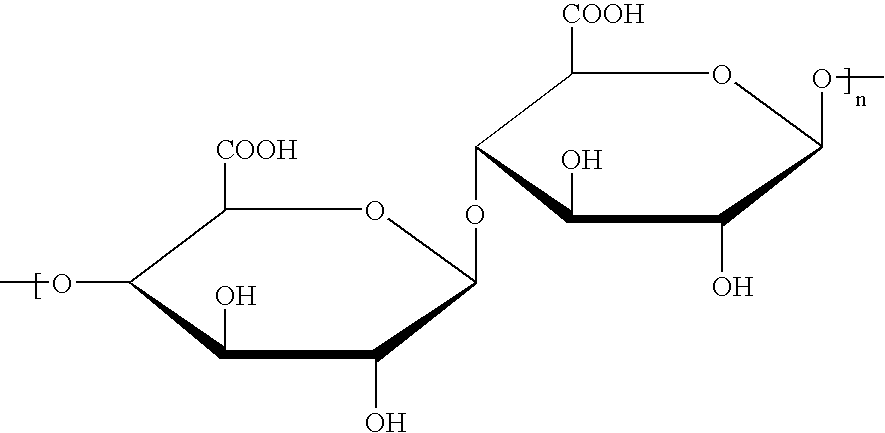Microcapsules IV
a microcapsule and active principle technology, applied in the field of new microcapsules, can solve the problems of anionic, capsules lack stability in the presence of surfactants, and microcapsules that do not allow controlled release of active principles
- Summary
- Abstract
- Description
- Claims
- Application Information
AI Technical Summary
Problems solved by technology
Method used
Image
Examples
example 1
[0124]In a 500 ml three-necked flask equipped with a stirrer and reflux condenser, 3 g of agar agar were dissolved in 200 ml water in boiling heat. First a homogeneous disperson of 10 g of glycerol and 2 g of talcum in ad 100 g water and then a preparation of 0.5 g of sodium alginate, 10 g of paraffin oil, 0.5 g of Phenonip® (preservative mixture containing phenoxyethanol and parabens) and 0.5 g of Polysorbate-20 (Tween® 20, ICI) in ad 100 g water were added to the mixture over a period of about 30 mins. with vigorous stirring. The matrix obtained was filtered, heated to 50° C. and dispersed with vigorous stirring in 2.5 times its volume of paraffin oil cooled beforehand to 15° C. The dispersion was then washed with an aqueous solution containing 1% by weight of sodium lauryl sulfate and 0.5% by weight of chitosan (Hydagen® DCMF, Henkel KGaA) and then repeatedly with a 0.5% by weight aqueous Phenonip solution, the oil phase being removed in the process. An aqueous preparation contai...
example 2
[0125]In a 500 ml three-necked flask equipped with a stirrer and reflux condenser, 3 g of agar agar were dissolved in 200 ml water in boiling heat. First a homogeneous disperson of 10 g of glycerol and 2 g of talcum in ad 100 g water and then a preparation of 0.5 g of sodium alginate, 10 g of squalane, 0.5 g of Phenonip® and 0.5 g of Ceteareth-20 in ad 100 g water were added to the mixture over a period of about 30 mins. with vigorous stirring. The matrix obtained was filtered, heated to 50° C. and dispersed with vigorous stirring in 2.5 times its volume of paraffin oil cooled beforehand to 15° C. The dispersion was then washed with an aqueous solution containing 1% by weight of sodium lauryl sulfate and 0.5% by weight of chitosan (Hydagen® DCMF, Henkel KGaA) and then repeatedly with a 0.5% by weight aqueous Phenonip solution, the oil phase being removed in the process. An aqueous preparation containing 8% by weight of microcapsules with a mean diameter of 1 mm was obtained after si...
example 3
[0126]In a 500 ml three-necked flask equipped with a stirrer and reflux condenser, 3 g of agar agar were dissolved in 200 ml water in boiling heat. First a homogeneous disperson of 10 g of glycerol and 2 g of iron(II) oxide in ad 100 g water and then a preparation of 0.5 g of sodium alginate, 10 g of panthenol and 0.5 g of Phenonip® in ad 100 g water were added to the mixture over a period of about 30 mins. with vigorous stirring. The matrix obtained was filtered, heated to 50° C. and dispersed with vigorous stirring in 3 times its volume of soybean oil cooled beforehand to 15° C. The dispersion was then washed with an aqueous solution containing 1% by weight of sodium lauryl sulfate and 0.5% by weight of chitosan (Hydagen® DCMF, Henkel KGaA) and then repeatedly with a 0.5% by weight aqueous Phenonip solution, the oil phase being removed in the process. An aqueous preparation containing 8% by weight of microcapsules with a mean diameter of 1 mm was obtained after sieving.
PUM
| Property | Measurement | Unit |
|---|---|---|
| Temperature | aaaaa | aaaaa |
| Temperature | aaaaa | aaaaa |
| Temperature | aaaaa | aaaaa |
Abstract
Description
Claims
Application Information
 Login to View More
Login to View More - R&D
- Intellectual Property
- Life Sciences
- Materials
- Tech Scout
- Unparalleled Data Quality
- Higher Quality Content
- 60% Fewer Hallucinations
Browse by: Latest US Patents, China's latest patents, Technical Efficacy Thesaurus, Application Domain, Technology Topic, Popular Technical Reports.
© 2025 PatSnap. All rights reserved.Legal|Privacy policy|Modern Slavery Act Transparency Statement|Sitemap|About US| Contact US: help@patsnap.com


